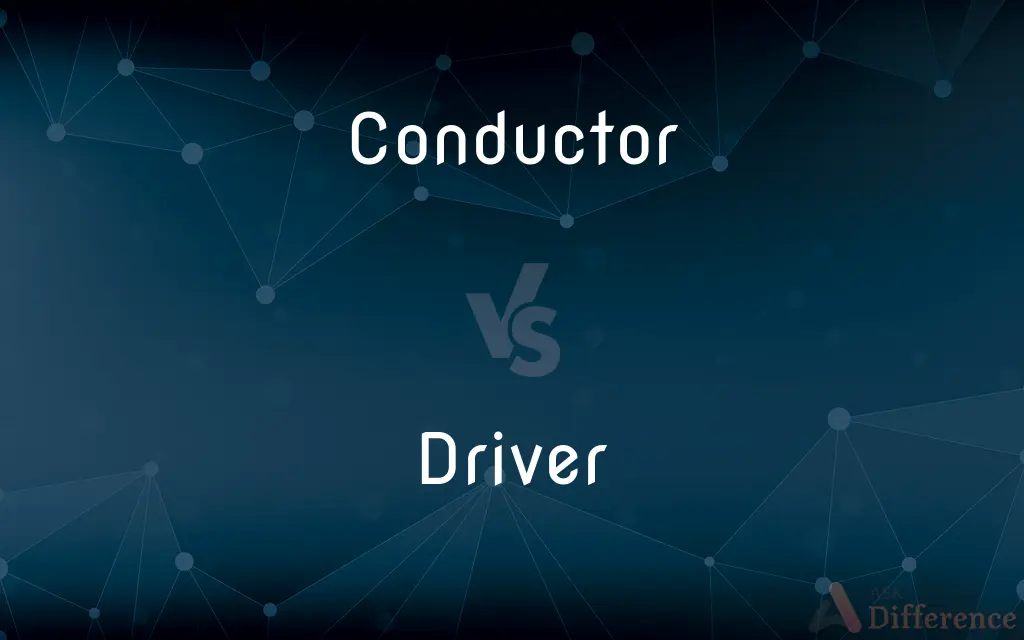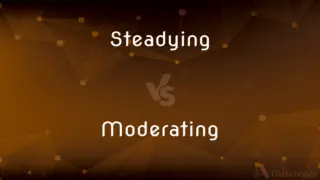Conductor vs. Driver — What's the Difference?
By Tayyaba Rehman & Maham Liaqat — Updated on April 24, 2024
A conductor oversees passenger safety and ticketing on trains, while a driver operates vehicles like buses and cars, focusing on navigation and vehicle control.

Difference Between Conductor and Driver
Table of Contents
ADVERTISEMENT
Key Differences
A conductor primarily manages the operations inside passenger trains, ensuring compliance with safety regulations and managing ticket collections. On the other hand, a driver is responsible for operating a vehicle, such as a bus, car, or truck, focusing on driving and adhering to road safety.
Conductors are integral to train services, coordinating with other crew members and assisting passengers with information and services. Whereas drivers, especially in road transport, work independently, handling all aspects of vehicle operation and passenger safety themselves.
In terms of training, conductors often require specialized knowledge of train systems, emergency procedures, and customer service. In contrast, drivers must master vehicle handling, navigation, and sometimes advanced driving techniques, depending on the vehicle type.
Conductors often have responsibilities that extend beyond mere transportation, including checking tickets, handling seating arrangements, and sometimes even announcing stations. On the other hand, drivers are primarily concerned with reaching destinations safely and on time, with minimal interaction regarding tickets or seating.
While conductors can be found on various types of trains, from local metros to long-distance railways, drivers are ubiquitous across all forms of road transport, from taxis and buses to heavy trucks and personal vehicles.
ADVERTISEMENT
Comparison Chart
Primary Role
Manages passengers, tickets, and safety
Operates and navigates the vehicle
Work Environment
Trains
Cars, buses, trucks
Interaction Level
High with passengers
Variable, often lower unless in public transport
Training Requirements
Train systems, safety procedures
Vehicle operation, navigation skills
Responsibility Scope
Beyond transportation, includes customer service
Primarily transportation-focused
Compare with Definitions
Conductor
Facilitator of passenger services and announcements.
The conductor announced the next station and available connections.
Driver
Person who operates and controls a vehicle.
The driver navigated the busy city streets with ease.
Conductor
Person who manages the operation and crew of a train.
The conductor checked all passengers' tickets as the train departed.
Driver
Primary operator of vehicles in public transport, delivery services, or personal use.
The driver carefully followed the GPS to deliver the packages on time.
Conductor
Individual responsible for ticketing and passenger conduct on board.
The conductor helped resolve a dispute over seating arrangements.
Driver
Individual responsible for the safety of their vehicle on the road.
The driver performed a quick vehicle check each morning.
Conductor
Role involving coordination with train engineers and station staff.
The conductor communicated with the engineer about the delay.
Driver
Position involving varying degrees of passenger interaction.
The bus driver greeted every passenger while checking tickets.
Conductor
Key figure in ensuring adherence to safety protocols on trains.
The conductor conducted a safety check before departure.
Driver
Role requiring knowledge of navigation and local traffic laws.
The driver took an alternate route to avoid the accident ahead.
Conductor
One who is in charge of a railroad train, bus, or streetcar.
Driver
One that drives, as the operator of a motor vehicle.
Conductor
(Music) One who directs an orchestra or other such group.
Driver
A tool, such as a screwdriver or hammer, that is used for imparting forceful pressure on another object.
Conductor
(Physics) A substance or medium that conducts heat, light, sound, or especially an electric charge.
Driver
A machine part that transmits motion or power to another part.
Conductor
A lightning rod, as on a house or barn.
Driver
A piece of software that enables a computer to communicate with a specific hardware device. Also called device driver.
Conductor
One who conducts or leads; a guide; a director.
Driver
A golf club with a wide head and a long shaft, used for making long shots from the tee.
Conductor
(music) A person who conducts an orchestra, choir or other music ensemble; a professional whose occupation is conducting.
Driver
(Nautical) A jib-headed spanker.
Conductor
(rail transport) A person who takes tickets on public transportation and also helps passengers.
Train conductor
Tram conductor
Driver
One who drives something, in any sense of the verb drive.
Conductor
(physics) Something that can transmit electricity, heat, light, or sound.
Driver
Something that drives something, in any sense of the verb drive.
Conductor
(mathematics) An ideal of a ring that measures how far it is from being integrally closed
Driver
A person who drives a motorized vehicle such as a car or a bus.
The requirement that every moving vehicle or combination of vehicles shall have a driver is deemed to be satisfied while the vehicle is using an automated driving system which complies with domestic technical regulations, and any applicable international legal instrument, ... and domestic legislation governing operation.
Conductor
A grooved sound or staff used for directing instruments, such as lithontriptic forceps; a director.
Driver
A person who drives some other vehicle.
Conductor
(architecture) A leader.
Driver
A pilot (person who flies aircraft).
Conductor
One who, or that which, conducts; a leader; a commander; a guide; a manager; a director.
Zeal, the blind conductor of the will.
Driver
(computing) A device driver; a program that acts as an interface between an application and hardware, written specifically for the device it controls.
Conductor
One in charge of a public conveyance, as of a railroad train or a street car.
Driver
(golf) A golf club used to drive the ball a great distance.
Conductor
The leader or director of an orchestra or chorus.
Driver
(nautical) a kind of sail, smaller than a fore and aft spanker on a square-rigged ship, a driver is tied to the same spars.
Conductor
A substance or body capable of being a medium for the transmission of certain forces, esp. heat or electricity; specifically, a lightning rod.
Driver
A mallet.
Conductor
A grooved sound or staff used for directing instruments, as lithontriptic forceps, etc.; a director.
Driver
A tamping iron.
Conductor
Same as Leader.
Driver
A cooper's hammer for driving on barrel hoops.
Conductor
The person who leads a musical group
Driver
A screwdriver.
Conductor
A device designed to transmit electricity, heat, etc.
Driver
One who, or that which, drives; the person or thing that urges or compels anything else to move onward.
Conductor
A substance that readily conducts e.g. electricity and heat
Driver
The person who drives beasts or a carriage; a coachman; a charioteer, etc.; hence, also, one who controls the movements of a any vehicle.
Conductor
The person who collects fares on a public conveyance
Driver
An overseer of a gang of slaves or gang of convicts at their work.
Driver
A part that transmits motion to another part by contact with it, or through an intermediate relatively movable part, as a gear which drives another, or a lever which moves another through a link, etc. Specifically:
Driver
The driving wheel of a locomotive.
Driver
The after sail in a ship or bark, being a fore-and-aft sail attached to a gaff; a spanker.
Driver
An implement used for driving;
Driver
The operator of a motor vehicle
Driver
Someone who drives animals that pull a vehicle
Driver
A golfer who hits the golf ball with a driver
Driver
(computer science) a program that determines how a computer will communicate with a peripheral device
Driver
A golf club (a wood) with a near vertical face that is used for hitting long shots from the tee
Common Curiosities
What does a driver primarily do?
A driver operates and navigates a vehicle, focusing on safe transportation.
Can drivers work in different types of transportation?
Yes, drivers can operate cars, buses, trucks, and other vehicles in various transportation sectors.
What kind of training is required for a conductor?
Conductors need training in train systems, safety protocols, and customer service.
What is the main role of a conductor?
A conductor manages passenger safety, ticketing, and train operations.
Where do conductors typically work?
Conductors work on trains, ranging from local metros to inter-city rail services.
What skills are essential for a driver?
Drivers must have strong vehicle operation skills and knowledge of navigation and traffic laws.
Do conductors interact more with passengers than drivers?
Generally, yes, as conductors manage passenger-related issues directly on trains.
Are drivers responsible for vehicle maintenance?
They are typically responsible for basic maintenance checks and reporting problems.
What additional responsibilities does a conductor have?
Conductors may also handle seating arrangements and make travel announcements.
How does the work environment affect a conductor's duties?
The train environment necessitates conductors to be vigilant about safety and operational protocols.
Is a driver's role the same in public transport and personal driving?
The basics are similar, but public transport drivers have additional responsibilities like ticket checking and passenger management.
Share Your Discovery

Previous Comparison
Mersh vs. Marijuana
Next Comparison
Steadying vs. ModeratingAuthor Spotlight
Written by
Tayyaba RehmanTayyaba Rehman is a distinguished writer, currently serving as a primary contributor to askdifference.com. As a researcher in semantics and etymology, Tayyaba's passion for the complexity of languages and their distinctions has found a perfect home on the platform. Tayyaba delves into the intricacies of language, distinguishing between commonly confused words and phrases, thereby providing clarity for readers worldwide.
Co-written by
Maham Liaqat













































